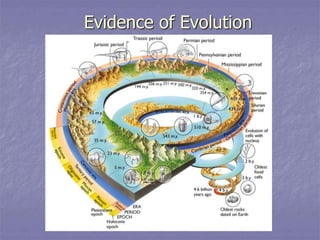Evidence_of_Evolution.ppt
•Download as PPT, PDF•
0 likes•7 views
This document outlines four key types of evidence that support the theory of evolution: fossils, comparative anatomy, embryology, and biochemistry. Fossils provide evidence of extinction, transitional forms between species, and changes in life forms over time. Comparative anatomy reveals homologous and vestigial structures that indicate common descent. Embryological development shows similarities across taxa. Biochemical similarities in proteins, DNA, and other molecules also support the theory that organisms share a common ancestry.
Report
Share
Report
Share

Recommended
More Related Content
Similar to Evidence_of_Evolution.ppt
Similar to Evidence_of_Evolution.ppt (20)
More from nona wayne dela pena
More from nona wayne dela pena (20)
Mixtures (Grade 8) - Free Printable Tests and Worksheets - HelpTeaching.com.pdf

Mixtures (Grade 8) - Free Printable Tests and Worksheets - HelpTeaching.com.pdf
657842078-Magnetic-Reversal.powerpointpresentation

657842078-Magnetic-Reversal.powerpointpresentation
sustaining earth's resources a LAC presentation.pptx

sustaining earth's resources a LAC presentation.pptx
Recently uploaded
Recently uploaded (20)
Topography and sediments of the floor of the Bay of Bengal

Topography and sediments of the floor of the Bay of Bengal
PRESENTATION ABOUT PRINCIPLE OF COSMATIC EVALUATION

PRESENTATION ABOUT PRINCIPLE OF COSMATIC EVALUATION
Constraints on Neutrino Natal Kicks from Black-Hole Binary VFTS 243

Constraints on Neutrino Natal Kicks from Black-Hole Binary VFTS 243
Cancer cell metabolism: special Reference to Lactate Pathway

Cancer cell metabolism: special Reference to Lactate Pathway
Climate extremes likely to drive land mammal extinction during next supercont...

Climate extremes likely to drive land mammal extinction during next supercont...
SAMPLING.pptx for analystical chemistry sample techniques

SAMPLING.pptx for analystical chemistry sample techniques
The ASGCT Annual Meeting was packed with exciting progress in the field advan...

The ASGCT Annual Meeting was packed with exciting progress in the field advan...
A Giant Impact Origin for the First Subduction on Earth

A Giant Impact Origin for the First Subduction on Earth
Circulatory system_ Laplace law. Ohms law.reynaults law,baro-chemo-receptors-...

Circulatory system_ Laplace law. Ohms law.reynaults law,baro-chemo-receptors-...
word2vec, node2vec, graph2vec, X2vec: Towards a Theory of Vector Embeddings o...

word2vec, node2vec, graph2vec, X2vec: Towards a Theory of Vector Embeddings o...
ESR_factors_affect-clinic significance-Pathysiology.pptx

ESR_factors_affect-clinic significance-Pathysiology.pptx
Evidence_of_Evolution.ppt
- 2. Evidence of Evolution EVOLUTION - genetic change in a population of organisms over time 4 Types of Evidence that scientists have gathered in support of evolution Fossils Comparative Anatomy & Structures Embryology Biochemistry (Proteins & DNA)
- 3. Fossils What is a FOSSIL? The preserved remains or traces of an organism that is no longer living Usually found in sedimentary rocks
- 4. What can fossils show? Organisms have appeared and disappeared, and have changed over time Extinction of species Transitional forms reveal links between groups: Archaeopteryx: between reptiles & birds Eustheopteron: amphibious fish Seymouria: reptile-like amphibian Also, mammal-like reptiles & whales with hind limbs Reveals ancient climate & environmental conditions Indicates development of life from simple to complex Indicates life began in water
- 5. Fossils Types of Fossils: 1. IMPRINT – thin, soft object (leaf, feather) is buried and sediments later harden 2. MOLD – Buried organism disappears and leaves an empty space 3. CAST – mold filled by minerals (replica of organism) 4. PETRIFICATION – minerals replace hard parts (bones, teeth, etc.) of organism 5. AMBER – entire organism fossilized in tree sap 6. FROZEN – entire organism frozen in ice 7. TRACE – footprints, trails, etc.
- 6. How can fossil age be determined? Depth of fossils help to determine their age Lower layers are older than those in upper layers Radioactive Isotope Dating Carbon-14, Uranium-238, Potassium-40 Measure the proportion of an isotope relative to its more stable form (half life)
- 7. Why is the fossil record incomplete? 1. Soft tissue rarely preserved 2. Movement of the earth’s crust has obliterated or covered many fossils 3. Fossilization takes place only in certain types of habitats and under favorable conditions 4. Paleontologists have not dug up every place on earth
- 8. Comparative Anatomy Study of anatomical structures to find similarities and differences HOMOLOGOUS STRUCTURES – parts with similar basic structure (derived from same structures in embryo—same common descent), but may vary in function
- 9. Comparative Anatomy ANALOGOUS STRUCTURES – structures that have the same function (may look somewhat alike), but have different structures and DO NOT have a common descent Example: wings have developed independently in insects, reptiles, birds, and bats
- 10. Comparative Anatomy VESTIGAL STRUCTURES – reduced body parts (in comparison to the same complex structure in other organisms) that have little to no function; remnant of an ancestor Examples: Human appendix (other mammals it is necessary to aid in digestion) Human external ear muscle (useless, but still there) Human tailbone (coccyx) Human wisdom teeth Bird wings – Penguins adapted for swimming, ostrich wings for balance and courtship
- 11. Embryology Patterns of embryological development can indicate a common ancestry Fish, birds, mammals & reptiles all have gills; only fish retain theirs Fish, birds, humans & reptiles all have tails; ALL but humans retain theirs
- 12. Biochemical Similarities Similarity of proteins, RNA & DNA molecules The more closely related organisms are, the more similar is the biochemical makeup Indicates common ancestor Universality of genetic code – supports evolution Similar chemistry & structure of chromosomes among Eukaryotes Chlorophyll is the same basic molecule in all photosynthetic organisms